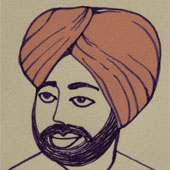Dastar Bandhi:
A very important and exciting event in the life of a Sikh boy is when he starts tying the turban. In a Sikh family this ceremony is held normally when the boy is between 11 to 16 years old. It is usually held in a Gurudwara before the Guru Granth Sahib and following Ardas. It is called Dastar Bandi. Sometimes the family will have a special function inviting close friends and relatives to celebrate the occasion. The boy is seated in front of Guru Granth Sahib. An elder relation ties the turban on his head. The Granthi (the reader of Guru Granth Sahib) explains to the boy why he must keep long hair and wear a turban. Prayers are said to invoke Guru’s blessing on the boy. The turban tied in this ceremony can be of any color; however baby pink is the most popular of all these days.

(Image Source)
Sehra Bandhi:
In Sikhs, the wedding happens during the day. On the same day, a custom called Sehra Bandhi is performed at the groom’s house before he leaves for Gurudwara for the wedding. During this the sisters of the groom ties ‘Kalgi’ (turban accessory) on his turban. This custom is derived from Hindu and Muslim weddings where ‘Sehra’- a flowery veil is tied on the groom's head to cover his face. However, in most Sikh weddings today the groom wears the veil along with the traditional ‘Kalgi’ on his turban.

(Image Source)
Rasam Pagri or Rasam Dastar or Bhog:
It is a ceremony conducted upon the death of the oldest male member in a family, in which the oldest surviving male member of the family is presented with a turban and declared the new head of the family in the presence of the extended family or clan. The turban signifies honour, and the ceremony signifies the transition of responsibility for the protection and welfare of the family from the deceased to the surviving oldest male member. The ceremony usually takes place on the 10th day from the day of funeral rites.
Source: Author

